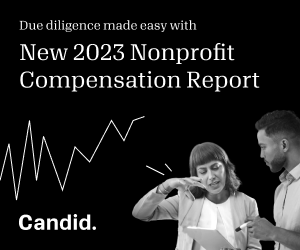Five trust-based behaviors to change power dynamics in philanthropy

As head of the fundraising team at a global philanthropic organization that both awards and receives grant funding, I’ve seen firsthand how donor policies and practices impact grantees.
I’ve witnessed how flexible funding and open communication enables grantee partners to adapt quickly in the face of crises. As a grantee, I’ve also seen how restrictive funding rules, burdensome reporting requirements, and a lack of communication can hinder responses to unexpected challenges and divert resources from projects.
Across the philanthropy sector, the COVID-19 pandemic prompted progress toward more flexible and trust-based practices. Yet, according to a report from the Technology Association of Grantmakers, the share of funders reducing funding restrictions was down from 41 percent in 2020 to 34 percent in 2022. The conditions that compelled the shift in 2020 remain, with new stressors related to climate change, the war in Ukraine, and other crises deepening the need for strong and reliable partnerships between philanthropy and communities.
The funder-grantee relationship is one with inherent power imbalances, but there are ways to level-set it. At Global Fund for Children, where I work, we’ve solicited anonymous feedback from our grantee partners and changed our policies and practices in response to further reduce barriers and increase flexibility. For example, we’ve taken steps to simplify our reporting process, provide longer-term funding, and foster more open, frequent, and informal communication with our partners.
During this process, we have realized that many of the challenges our partners have vocalized about their relationship with us mirror what we experience with our donors. The process of shifting our practices is a journey that is far from complete, but we have learned a few things along the way. Here are five recommendations for all donors, big and small, to build partnerships from a place of trust and responsibility.
1. Trust your partners
Onerous proposal and reporting requirements and 12-month grant terms limit the ability of grantees to plan over the long term. They also create a situation where organizations are engaged in an endless cycle of proposal writing and reporting with a donor, instead of strategic planning and long-term implementation. If multiyear grants aren’t yet a possibility, consider sharing your broad intentions with your grantee partners. It is helpful to know if you generally like to partner with the same organizations for several years or if you pivot year to year. Trust your grantees with this information and rely on them to understand and manage expectations. Funder initiatives like the Trust-Based Philanthropy Project can provide valuable guidance on building more equitable relationships with grantee partners.
2. Be flexible
Invest in an organization as a whole. Instead of building a strategy that is focused on supporting specific projects or providing highly restricted grants, create a strategy that supports organizations whose work you admire and trust. Build a relationship and funding commitment that allows them to grow their programming in organic ways, led by the communities they support. Trust them to try new things and give them space to fail without the risk of losing your support.
Providing flexible funding enables organizations to innovate and adapt to unexpected challenges on the ground. It also allows them to cover critical costs—like rent and salaries—that are essential for carrying out their work.
The Funding for Real Change initiative provides resources to help funders become more flexible with their funding, whether that means taking the first incremental step or deepening existing flexible funding practices.
3. Be an amplifier
Often, donors want to see evidence of an organization’s growth as a sign of strength and sustainability, but then hesitate to help raise their visibility. Share your power by making introductions to your peers, sharing your grantee partners’ work on your social media platforms, and inviting them into conferences, networks, and funding spaces with other donors. This networking, while free to the donor, is incredibly valuable to an organization that is trying to amplify its work and build its visibility.
4. Communicate more
Communicate often with your grantee partners. It is helpful for grantees to know how you’re feeling about the relationship as well as any restructuring or changes in vision or strategy at your organization that could impact them. If you’re concerned about budget allocations or the speed of implementation, it is important to talk about it and to listen with an open mind as grantee partners share their challenges and perspectives. Conversely, if you’re happy with the work and partnership, your partners would love to know that, too—it helps to know that they’re successfully communicating progress to you.
5. Be transparent about timing
The timing of your decisions matters a lot. Long review processes increase uncertainty. Partners start to worry about keeping on staff if decisions drag on beyond the end of the current agreement. They start to worry about how to uphold commitments to their communities if it takes a long time for a donor to make a funding decision. Ask your grantee partners how the timing of your gift would impact their planning, opening up a conversation about work planning, implications related to their revenue goals, and other factors that impact timing.
I encourage the philanthropic community to increase flexible, long-term support to their grantee partners. As part of a grantmaking organization in the process of implementing more trust-based practices, I know it can be done—and that the benefits far outweigh the risks. And as a grantee, I know how critical this support is to efforts to create positive social change.
Christine Burkhart is vice president of strategic partnerships at Global Fund for Children.








How to power shift in philanthropy: Lessons from The Share Fund’s radical approach to participatory grantmaking